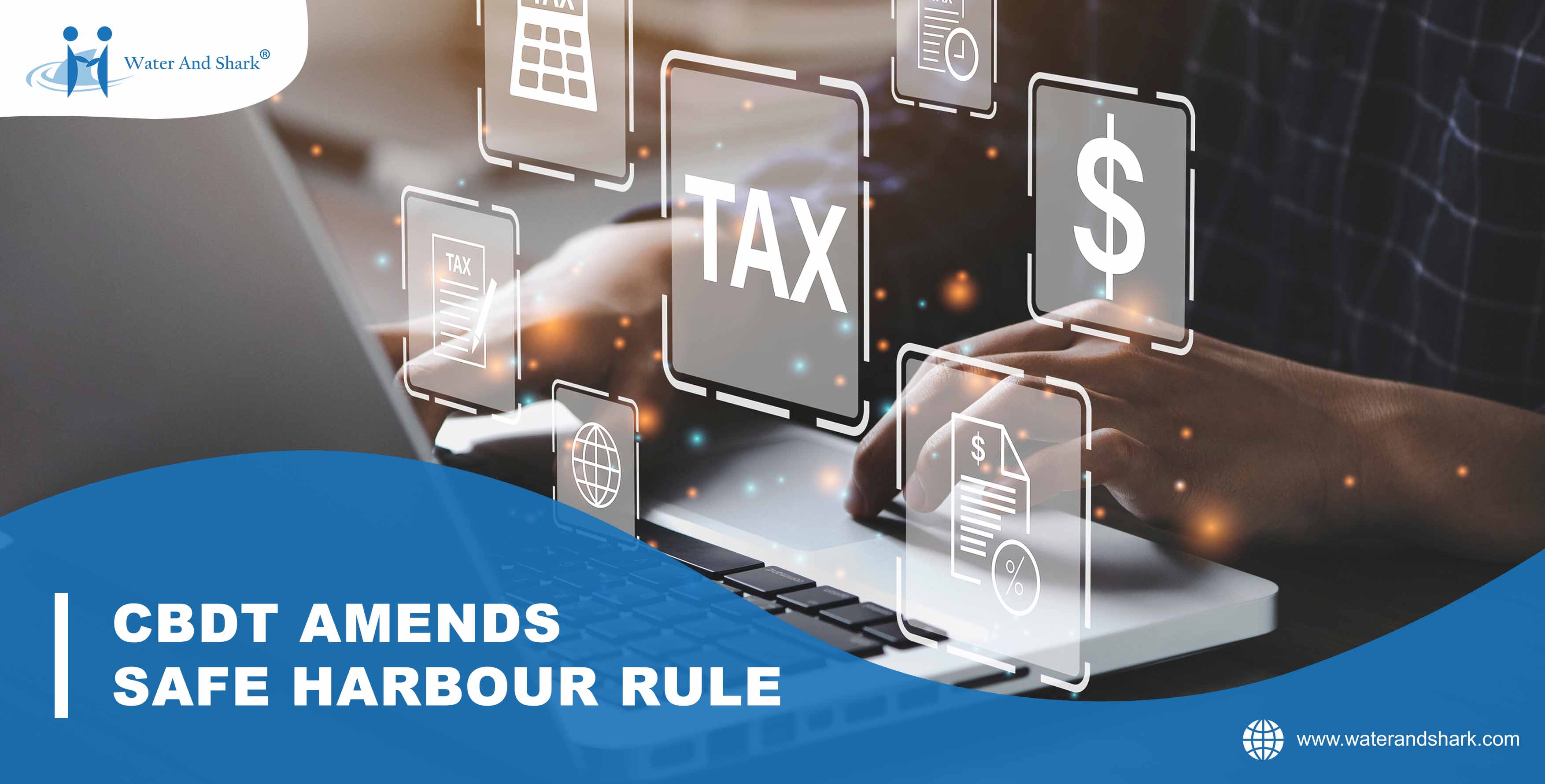CBDT’s New Amendments to the rule 10TA and rule 10TD of the Safe Harbour Rules
January 24, 2024 waterandshark
Introduction
The Central Board of Direct Taxes (CBDT) vide Notification1 dated 19 December 2023 has sought to amend the Safe Harbour rules, especially Rule 10TA and 10TD of the Income-tax Rules, 1962 (the Rules). These rules may be called the Income-tax (29th Amendment) Rules, 2023, and they are effective from the date of 1st April 2024. For further understanding the changes brought in, we must delve into the basic nuances of the “Safe Harbour Rules" and the rules governing the same leading upto the amendments introduced.
Jump right in:
Safe Harbour Rules
Ammendments
Conclusion
Safe Harbour Rules
With expanding international trade, the introduction of rules for Transfer Pricing Regulations and audits were felt of great need. However, the rules for transfer pricing regulation audits, the number of audits and prolonged disputes also saw a high rise. To reduce these increasing number of transfer pricing audits and resolve disputes, the Finance (No.2) Act, 2009 w.r.e.f 1.4.2009 inserted a new section 92CB to provide that determination of arm’s length price under section 92C or Section 92CA shall be subject to safe harbour rules. Section 92CB empowered CBDT OR “the Board" to make “Safe Harbour Rules". It was roughly explained as the conditions and circumstances under which income tax authorities shall accept the transfer prices as declared by any given Assessee to be at Arm’s length. And after great deal of consultations and discussions, the first safe harbour rules were notified by the board in the year 2013. It served as a legal provision designed to side-step legal or regulatory liability. This re-innovated the transfer pricing landscape, as it simplified the compliance process thus promoting more ease of business and trade.
Amendments
Rule 10TA- Definitions
- Rule 10TA talks about the definitions relevant for understanding of the new amendments. Rule 10TA(j) talks about the definition of “operating expenses" relevant for computation of ALP. Operating expenses are the expenses which are directly related to the core business activities. Depreciation on assets which are used directly in the core business operations will be treated as an operating expense. The new amendment suggests that the loss on transfer of assets or investments in which depreciation or amortization was included and accounted for as “operating expense" in nature, then that loss will be considered as “operating expense". The similar understanding works for amortization.
- Similarly, Rule 10TA(k) talks about the definition of “operating income" relevant for computation of ALP. Operating incomes are the incomes which are directly related to the core business activity which generate revenue. As earlier mentioned, Depreciation on assets which are used directly in the core business operations will be treated as an operating expense. The new amendment suggests that the income on transfer of assets or investments in which depreciation or amortization was included and accounted for as “operating expense" in nature, then that income will be considered as “operating income". The similar understanding works for amortization.
OLD RULE
NEW RULE AFTER AMENDMENT
Rule 10TA(j) stated the following definition of “operating expenses” used for the computation of ALP as follows:
“Loss on transfer of assets or investment which were operating in nature”
Rule 10TA(j) now states the following as the new meaning of “operating expenses” for the computation of ALP as follows:
“Loss on transfer of assets or investments in which depreciation is included in the operating expense are treated as operating expenses”
Rule 10TA(k) stated the following definition of “operating income” used for the computation of ALP as follows:
“Income on transfer of assets or investment which were operating in nature”
Rule 10TA(j) now states the following as the new meaning of “operating expenses” for the computation of ALP as follows:
“Income on transfer of assets or investments in which depreciation is included in the operating expense will be treated as operating income”
- Rule 10TA talks about the definition and Rule 10TD talks about eligibility of intra group loans. The definition was restricted to the loans given by Indian counterpart only to their wholly owned subsidiaries outside India and those shall be sourced in the INR (Indian National Rupee) currency. This restricted the overall scope based on grouping structure and INR denomination criteria.
So, in short, the old criteria were as follows:
- Loans are advanced from India to a wholly owned subsidiary outside India.
- The denomination or the source of such transaction shall be in Indian National Rupee.
OLD RULE
NEW RULE
Loans from India when advanced to their wholly owned subsidiaries outside India shall be in INR denomination.
Loans from India to their Associated Enterprise (not just their wholly owned subsidiaries) outside India can be advanced irrespective of the type of currency denomination.
Rule 10TD- Safe harbours
-
Rule 10TD(2A) has also been amended with regards to the advancement of intra group loans which are denominated in foreign currency. The loans that flow from the associated enterprise outside India to their Indian counterparts shall need “CRISIL" credit rating approval or an equivalent agency. The word “CRISIL" has been removed. It has further explained the new meaning of “credit rating" as follows:
“the credit rating assigned to the associated enterprise by a Securities and Exchange Board of India registered and Reserve Bank of India accredited credit rating agency which is applicable for the relevant previous year". Furthermore, it also states that, if the Associated enterprise has more than one applicable credit rating, then in such cases the lowest of the ratings shall apply.
OLD RULE
NEW RULE
Rule 10TD(2A) intra group loans from outside Indian counterparts to counterparts in India need “CRISIL” credit rating.
Rule 10TD(2A) intra group loans from outside Indian counterparts to counterparts in India need credit rating assigned to AE by SEBI or RBI
- Besides the above-mentioned changes, the amendment has also brought in a new change in reference interest rates. The earlier rule was in line with ‘London Inter-Bank Offer Rate' (LIBOR). However, under the new amendment, six alternative base rates have been introduced, namely Secured Overnight Financing rate (SOFR), Euro Inter Bank Offered Rate (EURIBOR), Sterling Overnight Index Average (SONIA), Tokyo Term Risk Free Rate (TORF), Bank Bill Swap Rates (BBSW) and Singapore Overnight Rate Average (SORA). Now it is a currency specific rates which are referenced as follows:
Hence, this suggests that the existing agreements should be looked through again and thoroughly re-evaluated and a fallback clause should be implemented if the interest rates are according to the earlier LIBOR arrangements.OLD RULE
NEW RULE
Currency
Reference Rate
LIBOR
USD (USA)
Secured Overnight Financing rate (SOFR)
EURO (European Union)
Inter Bank Offered Rate (EURIBOR)
GBP (UK)
Sterling Overnight Index Average (SONIA)
YEN (Japan)
Tokyo Term Risk Free Rate (TORF)
AUD (Australia)
Bank Bill Swap Rates (BBSW)
SGD (Singapore)
Compounded Singapore Overnight Rate Average (SORA)
- In reference to the above amendment, the minimum rates of interest applicable for such international transactions have also been altered from the domestic rates to the international benchmark reference interest rates. The interest rates have been increased by 45 basis points if the transactions are in the US Dollars and 30 basis points in the UK GBP (pound sterling).
OLD RULE
NEW RULE
USA - LIBOR
USA- Secured Overnight Financing rate (SOFR)+ 45 basis points
UK- LIBOR
UK- Sterling Overnight Index Average (SONIA)+ 30 basis points
- Earlier in the rule, there were no threshold limits for the loan amount to determine applicability for Safe Harbour (where credit rating was available), however this is now amended to provide different Safe Harbour for loans below INR 2.5 billion and above INR 2.5 billion. In connection to the same amendment above, earlier, the rule was a blanket range of credit ratings which is now specified, e.g., AAA to A is now AAA, AA+, AA, AA-, A+, A, A-. The overseas AE that wants to borrow funds in foreign currency, which is less than INR 2.5 billion from Indian counterparts and has a credit rating of BB+ or lesser, would now be eligible for lower spread. The Safe Harbour interest rate declared over the above reference rate is as below:
OLD RULE
Credit rating of the AE
NEW RULE
Credit rating of the AE
OLD RULE
NEW RULE
Loan if less than INR 2.5 billion
NEW RULE
Loan if more than INR 2.5 billion
AAA to A
AAA, AA+, AA, AA-, A+, A, A- or equivalent
No threshold limits of 2.5 billion INR of loans
150 basis points
150 basis points
BBB to B
BBB+, BBB, BBB- or equivalent
300 basis points
300 basis points
BB+, BB, BB-, B+, B, B- or equivalent
400 basis points
450 basis points
C+, C , C-, D or equivalent or not available
400 basis points
600 basis points
Conclusion
The taxation procedure and the litigation procedure that follows in the compliances have raised concerns in many growing and expanding businesses in the recent times. The disputes and differences in opinions regarding the determination of ALP have also been difficult in this journey of Transfer pricing. To curb these issues, the safe harbour rules had come into effect. With its own set of challenges, Safe Harbour rules are a much-needed provision for global traders, investors and multi-national companies (MNC). With growing trends in markets for India in recent times and with international interest only multiplying fourfold, seeking professional advice is a must. Contact us further at Water and Shark India for more information.
Leave a Reply
- Besides the above-mentioned changes, the amendment has also brought in a new change in reference interest rates. The earlier rule was in line with ‘London Inter-Bank Offer Rate' (LIBOR). However, under the new amendment, six alternative base rates have been introduced, namely Secured Overnight Financing rate (SOFR), Euro Inter Bank Offered Rate (EURIBOR), Sterling Overnight Index Average (SONIA), Tokyo Term Risk Free Rate (TORF), Bank Bill Swap Rates (BBSW) and Singapore Overnight Rate Average (SORA). Now it is a currency specific rates which are referenced as follows:





Comment